In Vivo Cognitive-Enhancing, Ex Vivo Malondialdehyde-Lowering Activities and Phytochemical Profiles of Aqueous and Methanolic Stem Bark Extracts of Piliostigma thonningii (Schum.)
- PMID: 32308992
- PMCID: PMC7128055
- DOI: 10.1155/2020/1367075
In Vivo Cognitive-Enhancing, Ex Vivo Malondialdehyde-Lowering Activities and Phytochemical Profiles of Aqueous and Methanolic Stem Bark Extracts of Piliostigma thonningii (Schum.)
Abstract
Cognitive impairment (CI) is among the leading causes of disability in humans. It is estimated that over 35.6 million people are suffering from Alzheimer's disease- (AD-) associated cognitive deficits globally with these statistics projected to rise over 115.4 million by the year 2050. There is no specific etiology for this cognitive impairment; however, various contributing factors including advancing age (>60 years old), oxidative stress, cerebral injuries, infections, neurologic disorders, and cancer have been implicated. Despite various attempts to manage CI, no curative medicines are yet available. The current drugs used to manage symptoms of AD-associated CI including Donepezil and Rivastigmine among others are only palliative rather than therapeutic. Furthermore, these agents have been associated with undesirable side effects. This calls for alternative and complementary approaches aimed at either preventing or reverting AD-related CI in a curative way without causing adverse events. It is estimated that over 80% of the world's population utilize herbal medicines for basic healthcare as it is considered safe, affordable, and easily accessible as opposed to conventional healthcare. Various parts of P. thonningii are used in traditional medicine to manage various conditions including CI. However, empirical and scientific data to validate these uses is lacking. In this study, the Morris water maze (MWM) experiment was adopted to evaluate the cognitive-enhancing effects of the studied plant extracts. The malondialdehyde (MDA) profiles in the brains of experimental mice were determined using the thiobarbituric acid reactive substances (TBARS) test. Moreover, qualitative phytochemical profiling of the studied plant extracts was performed using standard procedures. The results showed remarkable cognitive-enhancing activities which were reflected in significantly shorter transfer latencies, navigation distances, longer time spent in platform quadrant, and lower MDA levels compared with those recorded for the negative control mice (p < 0.05). Phytochemical screening of the studied plant extracts revealed the presence of antioxidant phytocompounds, which may have played key roles in the extracts' potency. Based on the findings herein, P. thonningii extracts, especially the aqueous ones have a promising potential for the management of AD-associated CI. Further studies aimed at isolating and characterizing specific active compounds for CI from P. thonningii are recommended. Additionally, specific mode(s) of action of active principles should be elucidated. Moreover, toxicity studies should be done on the studied plant extracts to ascertain their safety.
Copyright © 2020 Gervason Apiri Moriasi et al.
Conflict of interest statement
The authors declare that there is no conflict of interest whatsoever regarding this study.
Figures
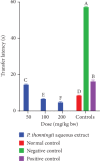
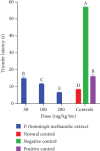
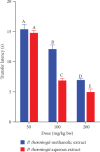
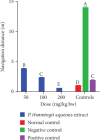
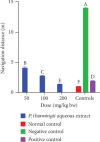
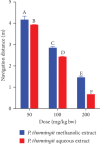
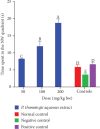
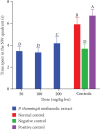
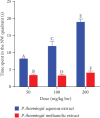
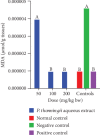


Similar articles
-
Cognitive-Enhancing, Ex Vivo Antilipid Peroxidation and Qualitative Phytochemical Evaluation of the Aqueous and Methanolic Stem Bark Extracts of Lonchocarpus eriocalyx (Harms.).Biochem Res Int. 2020 Oct 1;2020:8819045. doi: 10.1155/2020/8819045. eCollection 2020. Biochem Res Int. 2020. PMID: 33354371 Free PMC article.
-
In Vitro Antioxidant Activities of the Aqueous and Methanolic Stem Bark Extracts of Piliostigma thonningii (Schum.).J Evid Based Integr Med. 2020 Jan-Dec;25:2515690X20937988. doi: 10.1177/2515690X20937988. J Evid Based Integr Med. 2020. PMID: 32664742 Free PMC article.
-
Acute Oral Toxicity and Anti-inflammatory and Analgesic Effects of Aqueous and Methanolic Stem Bark Extracts of Piliostigma thonningii (Schumach.).Evid Based Complement Alternat Med. 2020 Aug 6;2020:5651390. doi: 10.1155/2020/5651390. eCollection 2020. Evid Based Complement Alternat Med. 2020. PMID: 32831869 Free PMC article.
-
Phytochemistry, pharmacology and ethnomedicinal uses of Ficus thonningii (Blume Moraceae): a review.Afr J Tradit Complement Altern Med. 2012 Dec 31;10(2):203-12. doi: 10.4314/ajtcam.v10i2.4. eCollection 2013. Afr J Tradit Complement Altern Med. 2012. PMID: 24146443 Free PMC article. Review.
-
Oroxylum indicum (L.) Kurz, an important Asian traditional medicine: from traditional uses to scientific data for its commercial exploitation.J Ethnopharmacol. 2015 Feb 23;161:255-78. doi: 10.1016/j.jep.2014.12.027. Epub 2014 Dec 25. J Ethnopharmacol. 2015. PMID: 25543018 Review.
Cited by
-
Cognitive-Enhancing, Ex Vivo Antilipid Peroxidation and Qualitative Phytochemical Evaluation of the Aqueous and Methanolic Stem Bark Extracts of Lonchocarpus eriocalyx (Harms.).Biochem Res Int. 2020 Oct 1;2020:8819045. doi: 10.1155/2020/8819045. eCollection 2020. Biochem Res Int. 2020. PMID: 33354371 Free PMC article.
-
Evaluation of the Antimicrobial Effect of the Extracts of the Pods of Piliostigma thonningii (Schumach.) Milne-Redh. (Fabaceae).Adv Pharmacol Pharm Sci. 2021 Feb 13;2021:6616133. doi: 10.1155/2021/6616133. eCollection 2021. Adv Pharmacol Pharm Sci. 2021. PMID: 33629066 Free PMC article.
-
In Vitro Antioxidant Activities of the Aqueous and Methanolic Stem Bark Extracts of Piliostigma thonningii (Schum.).J Evid Based Integr Med. 2020 Jan-Dec;25:2515690X20937988. doi: 10.1177/2515690X20937988. J Evid Based Integr Med. 2020. PMID: 32664742 Free PMC article.
-
Ethnobotanical Documentation, Phytochemical Screening, and Cytotoxicity Evaluation of Medicinal Plants Used to Manage Snakebite Envenomation in Mwingi West Subcounty, Kenya.Evid Based Complement Alternat Med. 2021 Sep 27;2021:4167296. doi: 10.1155/2021/4167296. eCollection 2021. Evid Based Complement Alternat Med. 2021. PMID: 34616476 Free PMC article.
-
Evaluation of Uterotonic Activity, Acute Oral Toxicity, and Phytochemical Composition of Uvariodendron anisatum Verdc. Root Extracts.Evid Based Complement Alternat Med. 2022 Aug 25;2022:7393537. doi: 10.1155/2022/7393537. eCollection 2022. Evid Based Complement Alternat Med. 2022. PMID: 36062174 Free PMC article.
References
-
- Alzheimer’s Association. 2018 Alzheimer’s disease facts and figures. Alzheimer’s & Dementia. 2018;14(3):367–429. doi: 10.1016/j.jalz.2018.02.001. - DOI
-
- Alzheimer’s Association. Early Signs and Symptoms of Alzheimer’s. Alzheimer’s Association; 2019.
-
- WHO. Geneva: World Health Organization; 2017. Global action plan on the public health response to dementia 2017 - 2025.
LinkOut - more resources
Full Text Sources

